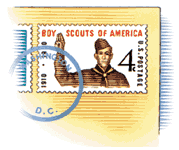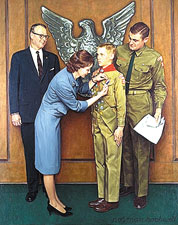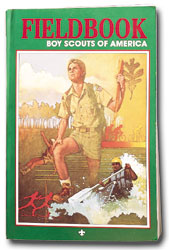![]() May-June 2000
May-June 2000

 A Great Moment (1965) |
I found Robert Peterson's article "Celebrating 90 Years of Strong Values and Leadership" in the January-February issue to be both informative and inspiring. I've even used some of the text in our most recent court of honor.
The article also included several illustrations of the late Norman Rockwell's impressions of Scouting. Is it possible to obtain prints or posters of these wonderful paintings? I can imagine the effect of these moving depictions on Scouts and Scouters at various meetings.
Jon Mitchell
Scoutmaster, Troop 132
Garland, Utah
Rockwell prints are available from several sources:
The January-February article "When Disaster Strikes" on troops and packs preparing for mobilization during an emergency was excellent; we have added it to our troop's reference file.
The article recommended maintaining a list of a unit's available cell phone and citizens band (CB) radio users. Organizers should also remember to include any amateur radio operators. "Hams" have both the equipment and training to provide much-needed help during a crisis.
Jim LeBaron, WA2IAX
Assistant Scoutmaster, Troop 99
Sidney, N.Y.
T he January-February article "Scouts on Skis" didn't mention the oldest and largest event of its kind in our state, the Boy Scout Ski Weekend at Bromley Mountain Ski Area.
The event has grown by word of mouth, and its 25th anniversary was celebrated this year on Super Bowl weekend. Scouts come from all over the Northeast; many troops make it an annual activity.
Troop 332 in Manchester helps arrange for Scouts to stay in churches, halls, and gyms. We feed them breakfast two days and dinner one night. They get to ski two days, enter a race with trophies, and have a great time with more than 1,200 other Scout skiers.
The money raised goes to support a number of local Scout units, the Green Mountain Council, and our summer camp program.
More information is available at the ski area's Web site, http://www.bromley.com, or via e-mail from louis@vermontel.net.
Louis H. Vastola
Chairman, Bromley Scout Ski Weekend
Manchester, Vt.

After reading the wonderful story about The Boy Scout Handbook in the September 1999 issue of Scouting, I wanted to see how many of the handbook's 11 editions I owned.
While going through my collection of Scouting books, I came across a 1948 edition of the Scout Field Book. Can you tell me the history of these books and how they were used in relation to The Boy Scout Handbook?
Ed Ziegler
Committee Member, Troop 56
Newark, N.J.
The three editions of the Fieldbook have served as a source of supplemental information on hiking, camping, and other outdoor activities—the "advanced skills not covered in basic manuals," as the preface to the second edition described the book's content.
The first edition (1944 to 1959) was titled Scout Field Book; it included information on advancement, troop and patrol activities, and traditional outdoor skills, plus a wide assortment of special techniques and skills, like smoke signaling, whip cracking, and birling (log rolling in water). The second edition (1967-1983) was first published as Field Book for Men and Boys, but the title was changed in 1973 to simply Field Book.
Publication of the third edition in 1984 converted the book's title to a single word, Fieldbook (Supply No. 33200). This current edition emphasizes low-impact camping and includes, along with traditional outdoor skills, sections on such special activities as horseback riding, caving, winter camping, whitewater rafting and kayaking, and outdoor and nature photography.
I would like to share the following letter, which my late husband, who was an active Scouter for many years, once wrote for a local unit newsletter:
Sparks From a Fire
When a boy learns to work, either through necessity or pleasure, he becomes a man.
The locker room was bursting with the voices of happy boys leaping under cold showers. New campers stripped and lined up for their camp physicals.
One by one they filed past Doc Keenan, who would thump their chests with hardly a word and call out, "Next!" The doc was an old hand at Cedar Point Scout Camp, a fixture for many summers past.
Finally, the doctor was looking into the face of the youngest camper. He frowned. "Who said you could come to camp?" he asked as he examined a fresh scar that told of an appendectomy only weeks before.
The youngest camper flushed. "My doctor," he stammered. "He said I must not swim or play softball. Please, can I stay?"
The pleading eyes told the story; two weeks of summer rode on the decision of old Doc Keenan. The doctor leaned over the medical form and wrote: "Camper must be limited to subdued activity."
That summer of long ago was a productive one for the youngest camper. There was no swimming, or boating, or softball, of course. Instead, merit badges [in] first aid, public health, forestry, conservation, and camping, and election to the Order of the Arrow.
I remember the youngest camper well. His name was the same as mine.
Yours in Scouting,
Dave Thompson
Susan Raye Thompson
Rochester, Minn.
My Eagle Scout son, Mark, turned 18 as one happy Boy Scout who had a tremendous career from Tiger Cub through Eagle Scout in Troop 157, chartered to the Herndon United Methodist Church.
Most importantly, Mark got a career out of his Scouting experience, thanks to the training he received from two adult leaders in his troop: George Sheflett and John Stone, who ran the cook crew for major Order of the Arrow regional events.
Mark served as lodge cook crew chief from age 16 to 18. He planned menus, bought $5,000 in food, learned to operate industrial kitchen equipment, and directed a crew of adults and Scouts in preparing weekend meals for up to 600 people.
His Scout-earned cooking skills helped Mark compete for and win a $40,000 culinary scholarship to Johnson & Wales University, Providence, R.I., where he is completing his second year of a four-year culinary arts program. Mark also received Eagle Scout and Junior Achievement scholarships and recently won first place in the Ice Carving Team Competition as part of the U.S. Ice Carving National Collegiate Championships.
As a parent and an Eagle Scout, I am both proud of and grateful to the BSA program and the many outstanding adult leaders who have had a significant impact upon my son, particularly those in the National Capital Area Council, where Mark's Scout career took place. Among these are Scout Executive Ron Carroll, who recommended Mark for his Eagle Scout scholarship, and former OA lodge adviser Harold Ramsey, who was a major influence as Mark learned about the OA tradition of "cheerful service."
Ted Tempel
Assistant Scoutmaster, Troop 157
Herndon, Va.
I am an assistant Cubmaster and den leader who has been certified as a BB and archery range master. I would like to know how long this certification will be valid.
John Alan Burgess
Hickory, N.C.
The answer to your question can be found on page 58 of the Cub Scout Day Camp manual (BSA Bin No. 13-33815). The last paragraph under the Safety and Marksmanship Program reads: "The local council should issue a pocket training certificate (BSA Supply No. 33767) and keep a record of the people who have been certified. Certification must be renewed every two years."
The Green Bar Bill's Patrol Corner with the easy-to-make recipes in the October issue was very much appreciated.
I count myself among the "culinary-challenged" (although eating good food has never been a problem). More than five or six ingredients in a dish, and I'm really in a pickle. My eyes glaze over, and I become hopelessly overwhelmed trying to prepare it. (I'm not alone; I've found that most of our Scouts also lean toward less complicated recipes.)
I'd bet a week's "celery" that, out there somewhere, there must be more of these "easy-as-pie" ideas.
Crowd pleasers our Scouts have come to know and love include "Dump Cake" and one of their favorite meals, "Coca-Cola Chicken."
We hunger for more of these kinds of main dish and dessert ideas. Hopefully, more will "turnip" in the magazine if you can stir in something like the Green Bar Bill article more often.
Gordon Graham
Assistant Scoutmaster, Troop 2
Pellston, Mich.
For readers interested in the Dutch-oven dessert dish Dump Cake, we've provided the recipe below. It is one of 18 recipes found in the Cooking section of the BSA publication Troop Program Features, Vol. 1 (Supply No. 33110).
More easy-to-do dishes will certainly be among the recipes submitted by readers in the latest edition of Scouting magazine's annual competition for readers. The theme is "Great Tastes in Camp Cooking," and details on how to enter are in News Briefs.
I was delighted to see the September 1999 Family Fun Page dedicated to the California Gold Rush because our state has been enjoying a three-year sesquicentennial celebration, "Gold Discovery to Statehood."
The Greater Yosemite Council used "1849: the Gold Rush Year" as the theme for our 1999 camporall, [which] was an official sesquicentennial event. Later, at the Tuleburg-Mudville dock (Port of Stockton), the California Republic Bear Flag that had flown over our camporall greeted the state's sesquicentennial wagon train and the tall ships that sailed up the channel from San Francisco.
Also, the Historic Trails patch for our council's "California Gold Rush Historic 49'er Trail" award was unveiled; the patch can be purchased by Scouts and members of the general public who qualify for the award. Contact the council at (209) 545-6320 or (209) 944-0049 for more information if you plan to visit the "Gold Country" of California through the end of 2000.
Jim Fox
Activities Chairman
Greater Yosemite Council
Stockton, Calif.
| The Boy Scouts of America | http://www.scouting.org |